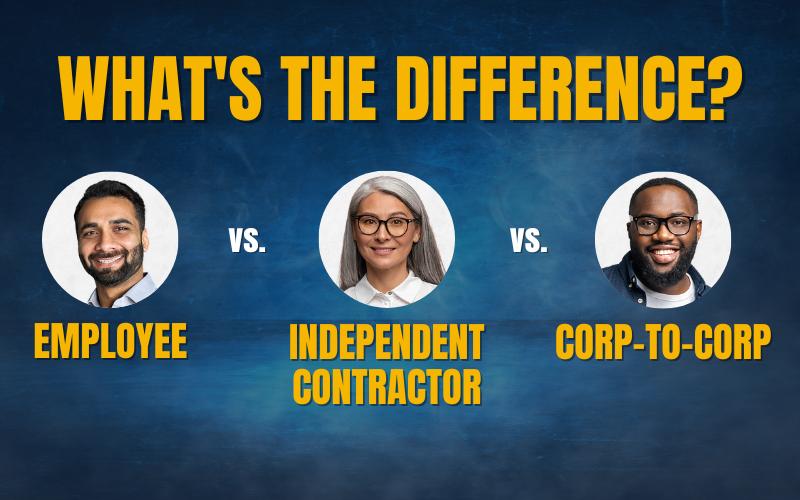If you’ve traditionally employed full-time employees, you might have some questions about the different types of work arrangements that have gained momentum over the past few years. With the rise of the internet and tech companies that have enabled the gig economy, more workers are eschewing full-time employment for the flexibility of less permanent working arrangements — known as the contingent workforce.
This blog post will look at the three different types of contingent workers whom companies can engage and will examine the pros and cons of each. By the end, you’ll be equipped to make more informed decisions about the best way to classify your own company’s workers.
Employee
Most workers categorized as ‘employees’ work for a single company full- or part-time and are what is known as a payrolled worker or contract employee. They get the security of consistent employment (even if it is temporary or on a fixed term) and access to the equipment and training necessary to perform the job, and the company controls many of the terms of the arrangement, including when, where, and how the work is accomplished. As a result, these employees are given an employee tax form at the end of each year (in the U.S. this is a W2 tax form). The employer has to pay employer taxes, and withholds the employee taxes and remits to the government on behalf of the worker. Employees also get certain protections that we’ll discuss in the next section.
Independent Contractor
If you’ve ever wondered what a self-employed position means (for example, in the U.S. a 1099 worker), it’s simply the classification of a worker as an independent contractor instead of an employee. An independent contractor operates as an unincorporated, individually owned business, and in many ways, these workers can be viewed as the opposite of an employee. They are responsible for paying their own taxes, both at filing time and quarterly throughout the year, and they aren’t entitled to the rights and responsibilities of an employee such as notice periods for ending the relationship, paid annual leave, contribution to retirement/pension plans, health benefits (in the U.S.), etc. There are many different types of independent contractors, but a few examples include freelance writers, graphic designers, photographers, consultants, and many other self-employed business owners and skilled workers that specialize in a trade.
Corp-to-Corp
Companies can also hire corp-to-corp workers by engaging the services of an incorporated contractor. The arrangement of corp-to-corp versus an independent contractor is similar, but it means you’ll pay an LLC or corporation, rather than the worker, for their company’s services. In addition, the contracted corp-to-corp worker must own an LLC or a corporation. If Nike hires a shoe design consultant who owns Savvy Sneakers, LLC, for example, Nike is engaging the worker under a corp-to-corp arrangement.
What are the Benefits of Each Worker Classification?
Although it’s obvious that companies have more obligations toward employees versus Independent Contractors and corp-to-corp workers, there are pros and cons for each type of engagement.
员工
Employees are typically working for only your company, and they contribute an enormous amount to establishing the kind of culture you have. Your company also has granular control over when, where, and how the employees perform the work they’ve been hired to do, which isn’t the case with independent contractors.
独立承包商
That said, engaging an independent contractor allows you to bring specialized skills into your organization without having to navigate a time-consuming and expensive hiring process. Outsourcing certain projects or skills gives you the flexibility to accomplish tasks that might be beyond your existing employee base and outside the normal function of your business.
Corp-to-Corp
A corp-to-corp worker comes with the same benefits, but they also protect your company from some of the dangers of misclassification because a vetted corporation is performing the work instead of an individual.
What is the Tax Rate for Each Worker Classification?
Taxes are an important — and expensive — consideration when hiring temporary employees. Your company must pay all employer taxes, which vary from country to country. In the U.S. for example, employment taxes include the 6.2% federal income tax as dictated by the Federal Insurance Contributions Act (FICA), another 1.45% for Medicare, a state unemployment tax ranging from 0.5% to 14% (depending on the state the worker is in), and a federal unemployment tax of 0.6%.
These taxes add up, particularly when viewed next to the tax burden associated with independent contractors, who must pay their own self-employment taxes and income tax. However, they can take tax deductions to significantly lower their tax liability.
Corp-to-corp workers are also responsible for their own business taxes as an LLC or incorporated entity.
Contingent Worker Contracts
Different types of contingent workers rely on different contingent worker contracts. The standard independent contractor contract speaks directly to the relationship between the two parties, and the “recitals” section identifies each party and their contractual partnership. An independent contractor contract should include clear expectations and deliverables through a State of Work, but it doesn’t include when and how the work is to be completed because independent contractors have full control over their work and time.
In corp-to-corp agreements, the difference is mostly in the recitals section, which lists two companies in partnership instead of a company and an individual contractor. Like the independent contractor contract, the corp-to-corp contract doesn’t specify how the outside corp will accomplish the receivables dictated in the contract.
As you are probably familiar with, an engagement with an employee begins upon an agreed upon start date and executed employment contract outlining the employee and employer responsibilities. This initiates the employer/employee relationship and creates the obligations on behalf of the employer.
Determining the Right Work Arrangement for Your Next Hire
Now that you know the basic requirements for the different types of contingent workers, you can determine whether an employed worker versus an independent contractor or a corp-to-corp relationship is right for your company.
However, despite the benefits of hiring contingent workers, your company may have certain policies that encourage or prohibit the use of them, particularly regarding independent contractors, so it’s a good idea to talk to someone in your human resources department prior to posting any job openings.
If you receive the green light to engage an independent contractor, it’s important to implement a thorough vetting process or outsource this classification step to a third-party. This should cover how the company plans to engage the worker, but also whether the company wants control over how, when, and where the worker provides services, whether existing employees perform the same or similar work, and whether the services provided are core to the business or something outside the company’s normal scope of business. In addition, the vetting process should determine whether the contractor is truly an independent business that promotes itself to the marketplace and takes on other clients.
These steps might seem overly cautious, but they help ensure that the worker classification is in line, and therefore help your company avoid potentially significant liabilities resulting from misclassification. Worker classification issues are increasingly common as different states and countries continue to revamp their laws pertaining to these practices. In the U.K. for example, introduction of IR35 for the private sector took effect from April 2021 and represented the biggest change to employment tax in decades. However the subsequent repeal of this reform in September of 2022, isn’t as clear as it may seem.
It’s an important reminder about the perils of worker classification issues and a strong reason why you should familiarize yourself with the different types of contingent workers and rules for engaging them.
Take the Risk Calculator Assessment
IF your company is not clear on your worker classifications, take a quick assessment with our Risk Calculator. This interactive tool assesses your risk level, liability, and potential penalties and fees in the U.S. in just a few steps.
Learn more about employee misclassification and risk mitigation.
Written by: Sara Jensen, Senior Vice President of Growth & Strategy at IES
Sara Jensen is the senior vice president of growth & strategy at Innovative Employee Solutions (IES), a leading provider of remote and contingent workforce solutions, specializing in global Employer of Record, Agent of Record and Independent Contractor compliance services in 150+ countries. Founded in 1974, IES is a woman-owned business, certified by the WBENC and partners with companies to provide compliant employment solutions that empowers people’s lives.






